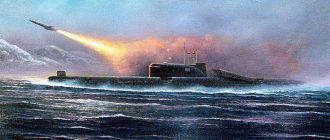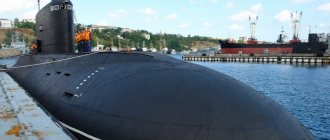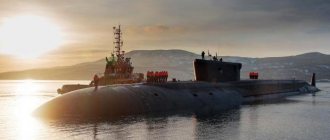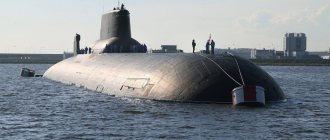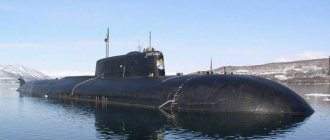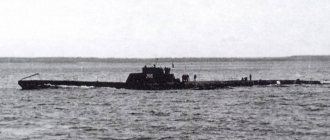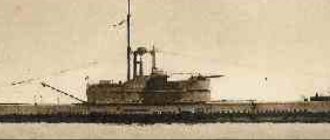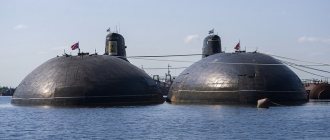The Soviet Union understood perfectly well how important it was to have a powerful nuclear missile submarine fleet in constant combat readiness, capable of causing irreparable damage to a potential enemy at any time. The work to create a new generation of submarine missile carriers, which began in the mid-70s, was the USSR’s response to the creation of Ohio-class nuclear submarines in the United States. In September 1975, a government decision launched the start of work in this direction, which resulted in the project of the domestic third-generation missile carrier 667BDRM.
The birth of the project and the construction program for Soviet third-generation missile carriers
To achieve this goal as quickly as possible, the designers of the Rubin Central Design Bureau did not reinvent the wheel. The main efforts were made to modernize the existing project of the Project 667BDR Kalmar missile carrier.
This submarine belonged to the ships of the second generation, however, in many technical and technological parameters, the design of the ship made it possible to achieve significant modernization. Having made significant adjustments to the existing project, Soviet designers managed to obtain an almost new warship. The main accents in the new project were:
- introduction of technical means to reduce the hydroacoustic noise of the boat;
- adaptation of the boat's hull and systems to new types of weapons;
- installation of new navigation systems, control and target detection equipment.
For this purpose, design bureau specialists and shipbuilders produced a huge number of experimental stands on which new sound-absorbing devices and means of reducing vibration insulation were tested. Work was actively carried out to reduce the sonar visibility of individual parts of the structure. The new Project 667BDRM Dolphin submarines, according to calculations, were supposed to deprive the Americans of their advantage in the field of strike strategic weapons.
In addition, the new submarine received a new hull, the surface of which was covered with a special insulating material. An additional structure appeared in the hull - a long hump stretching across the entire hull behind the wheelhouse. This element became a signature feature of domestic missile carriers, distinguishing them from all existing ships of this class. This part of the hull housed 16 ballistic intercontinental missiles with a range of over 8 thousand km.
The first ship of Project 667BDRM, called K-51, was laid down in 1981 at the shipyard of the Severodvinsk Machine-Building Plant. The construction of the boat took three years. In the winter of 1984, the boat was launched, and in December of the same year the ship became part of the Navy of the Soviet Union. The ship was striking in its size and appearance, reminiscent of a huge humpbacked sea animal. The huge cigar had a length of 167 meters and a displacement of over 10 thousand tons. Even at the time of construction, the Soviet missile carrier in the West was assigned the code “Delta IV,” classifying the ship as an underwater missile carrier with enormous combat power.
Following the lead boat, 6 more submarines of the same type entered service. In the period from 1984 to December 1990, the Soviet Union acquired a whole flotilla of the most powerful submarines, which became the most important element of the country's nuclear missile shield. After the collapse of the Soviet Union, these ships fell to become the main elements of the naval component of the nuclear triad of the Russian Federation. Six ships, having undergone preventive and major repairs at a certain time, are currently in service and on combat duty. The ships are part of the 31-1 submarine division and are based at the Gadzhievo naval base. One submarine K-64, which later received the number BS-64, was converted into a carrier of small submarines.
Despite the fact that the very first ship of Project 667BDRM, the K-51 Verkhoturye boat, was launched more than 30 years ago, the submarine today is in full combat readiness. After a major overhaul carried out at , the updated and modernized submarine returned to service at the end of 2012. Her younger sisters, the submarines K-114 Tula and K-117 Bryansk, previously underwent medium repairs and are now on combat duty.
Links[edit]
- ^ B s d e g h i J "Dolphin IV (PG-24)". Dictionary of American Naval Combat Ships
. Department of the Navy, Naval History and Heritage Command. July 7, 2015. Retrieved January 19 +2016. - ^ abc Friedman, pp. 18-22
- ^ abcd Bauer and Roberts, page 161
- DiGiulian, Tony, USA 6"/30 and 6"/35 guns on Navweaps.com
- DiGiulian, Tony, USA 6-pounder at Navweaps.com
- ^ ab Gardiner and Chenault, page 163
- DiGiulian, Tony, USA 3-pounder on Navweaps.com
- DiGiulian, Tony, USA 4″ / 40 guns on Navweaps.com
- DiGiulian, Tony, USA early 3″ / 50 guns on Navweaps.com
- DiGiulian, Tony, USA 4″ / 50 guns on Navweaps.com
- ^ ab USS Dolphin (PG-24) at NavSource.org
- ↑
"I Was the First to Sing on the Radio" by Eugenia H. Farrar,
The American Swedish Monthly
, January 1955, pages 10, 26. - "Wireless Pioneer Society: Membership Statement and History: Oliver A. Wyckoff, Sr." (pdf), July 30, 1969.
- Gardiner and Gray, p. 417
- This article incorporates text from the Public Access
Dictionary of American Naval Combat Ships
. The recording can be found here.
Features of the 667BDRM project
The Russian Navy received a good inheritance in the form of Project 667BDRM submarines. Thanks to their design, the submarines proved to be survivable. Several serious accidents that accompanied the ships' combat service were quickly eliminated. In addition, the design of the boat itself made it possible, without any special design changes, to carry out its modernization in accordance with the technical requirements of new types of weapons. The main reason for such versatility is the high design characteristics of the ships, which have absorbed all the best that domestic shipbuilders have been able to achieve over the years of building ships of this class.
A number of technical solutions used in the design of the submarine can be compared with the technologies of space programs. What does the noise suppression system of a submarine ship cost? According to these characteristics, Soviet, and now Russian, submarine missile carriers are considered the quietest. While on combat duty, it is almost impossible to track the location of the ship. Even during the design process, the polar regions of our planet were identified as the main area of operation of the new ships. Operating on the border between the edge of the ice shell and clear water, Soviet submarines could remain beyond the range of sonars of US Navy ships and NATO countries for a long time. Detection of domestic Delta IV class missile carriers became a big problem for a potential enemy.
Operating in coastal areas and being under constant cover of the fleet's surface forces, Project 667BDRM boats become virtually invulnerable. In such conditions, the territory of a potential enemy became defenseless from a retaliatory nuclear missile strike.
It should be noted that the missile cruisers of Project 667BDRM became the first domestic boats from which a full-fledged missile salvo of the entire ammunition on board was carried out. Despite the failure, the preparatory measures and subsequent actions to eliminate the emergency formed the basis of an entire program to improve the survivability of the submarine.
Considering the project as a whole, it is worth noting the design features of the boat. The main detail is the increased height of the missile silo fencing. This was done in view of the subsequent installation of R-29RM ballistic liquid-fuel missiles on combat vessels. The three-stage rocket reached a height of 14.8 meters and weighed over 40 tons. The submarine was equipped with 16 such missiles with two warhead options - ten-block and four-block.
Due to the increased size of the missile armament, it was necessary to increase the dimensions of the pressure hull. The light version received new lines and a configuration in the area of 1-3 compartments. Due to the high noise requirements of the ship, special devices were installed in a number of its compartments - sound absorbers and vibration compensators. The steel used in the construction of the light and durable hull allowed the submarine to descend to a working depth of 400 meters. The maximum permissible diving depth of the ship was 650 meters.
The power plant on the Project 667BDRM submarines was represented by two VM-4SG nuclear reactors, which have a total power of 180 MW. Both nuclear reactors drive the main gas-energy turbine unit with a capacity of 60 thousand l/s. The submarine was driven by two five-blade propellers, which gave the ship an underwater and surface speed of 24 and 14 knots, respectively.
To power the ship in autonomous mode, two diesel generators and two turbogenerators were installed on the boat, providing electricity to the ship’s life support systems and low-speed propulsion.
The internal layout of the ship deserves attention, in which they tried to take into account all aspects of increasing the level of comfort for the submarine crew. Boats of this type now have saunas, solariums, sports and gyms. The air regeneration system has undergone a qualitative change, making it possible to maintain a safe chemical composition of the air in the interior of the submarine.
External links [edit]
| Wikimedia Commons has media related to USS Dolphin (PG-24) . |
- Photo gallery of USS Dolphin (PG-24) on NavSource.org
- Naval History and Heritage Command: USS Dolphin IV (PG-24)
- Naval History and Heritage Command: USS Dolphin (1885–1922) photos
- Dolphin IV (PG-24) at Naval History and Heritage Command
- USS Dolphin at SpanAmWar.com
| vteEvolution Squadron of the US Navy | |
| |
Weapon system
There is no need to say much about the main weapon of the Project 667BDRM ships. Today, all six ships in the Russian fleet have been converted to carry new modernized modifications of the R-29RMU2 and R-29RMU2.1 liner-type ballistic missiles. The number of missiles remains the same - 16 pieces, but all warheads have four warheads. The D-9RM missile system, which is equipped with Russian missile carriers of Project 667BDRM, is considered one of the most powerful nuclear missile systems overseas. A missile salvo can be fired from the ship's underwater position at a depth of up to 55 meters.
As a tactical weapon, the boats are equipped with a mine-torpedo system consisting of 4 torpedo tubes of 533 mm caliber. The boat can fire all currently existing torpedo weapons, including missile torpedoes. The supply of torpedoes is 12 pcs. The huge ship is controlled through. Through this complex, incoming information about the goals and conditions for maneuvering and subsequent combat use of the ship’s weapons is processed. A serious advantage that the modernized Project 667BDRM boats have is the presence of the new Skat hydroacoustic system. The new SAC is equipped with a large antenna protected by a fiberglass radome.
The ship's air defense is entrusted to 9K310 anti-aircraft missile systems, which are at the disposal of the crew members. The ship is controlled by a crew of 140 people.
The near future of the ship
Based on the need of the Russian Navy to have up to 10 combat-ready submarine missile carriers in service, a decision was made at the highest level to maintain Project 667BDRM ships in a high degree of technical readiness. The technical condition of all six ships belonging to the 31st division is currently satisfactory. The newest of all the missile carriers of this project, the K-18 Karelia submarine, underwent a major overhaul in 2010. According to preliminary data, the ship's service life has been extended for another 10 years. Similar events affected other Project 667BDRM submarines. It is assumed that the entire division will be able to adequately carry out combat duty until 2025.
In addition to being on combat duty, Russian submarines, in order to maintain combat readiness at a high level, participate in the launch of commercial cargo as part of the development of space programs. R-29RM rockets are used to launch artificial satellites. Thanks to such programs, it is possible not only to maintain the missile system at the proper level, but also to monitor all ship systems.
The prospects for Russian submarine missile carriers today do not look entirely rosy. An urgent question arises about ensuring the technical base of operating ships, the service life of which is naturally coming to an end. In the plans of the Navy command to modernize the domestic fleet, Project 667BDRM submarines occupy an important place today. It is they who must ensure the country's defense capability for the transition period until new submarines enter service and until the modernization of submarines of other classes is completed.
Training attacks
On the afternoon of September 22, 1906, the submarine “Mullet” supposedly sank the cruiser “Zhemchug” at anchor in Novik Bay. While in the Amur Bay, "Mullet" took a position advantageous for attack and simulated a shot from the bow apparatus from a distance of 3-3.5 cables (about 600 meters). Observers on the cruiser did not notice the periscope of the attacking submarine.
Continuing the training attack, the boat shortened the distance by another 400-500 meters, surfaced under the periscope and simulated a shot from the second bow apparatus. Then, having performed a maneuver in depth and heading, she turned around and “fired” at the cruiser from the stern apparatus. The submariners exited the bay, maintaining a diving depth of seven to eight meters. Since a periscope was discovered on the cruiser only before the “second torpedo shot,” the attack was considered successful.
The submariners also practiced their actions in the event of a night attack. Having entered the bay unnoticed and continuing to move on the surface at low speed, the Mullet approached the cruiser Zhemchug at an extremely short torpedo firing range. And in a submerged position, the cruiser’s observers could not distinguish the submarine even close up, when it was moving at low speed under the periscope.
